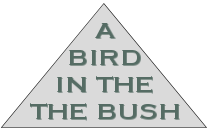Invisibility via Visibility
 In Banachek’s killer book, Psychological Subtleties 2, he tells a story of someone he knew who got a parking ticket. The basic gist of it was that this person parked in this particular spot almost everyday. Then one day a no parking sign was added. However, he never noticed the sign because he wasn’t looking for it. When he went to court he showed the judge an image that looks like the one to the left. He asked the judge to read it, so I’ll ask you to do the same . . . I’ll wait . . .
In Banachek’s killer book, Psychological Subtleties 2, he tells a story of someone he knew who got a parking ticket. The basic gist of it was that this person parked in this particular spot almost everyday. Then one day a no parking sign was added. However, he never noticed the sign because he wasn’t looking for it. When he went to court he showed the judge an image that looks like the one to the left. He asked the judge to read it, so I’ll ask you to do the same . . . I’ll wait . . .
Now that you read it, there’s a pretty good chance that you didn’t notice the extra “the” in the sentence. The point to the judge was that people don’t notice things if they’re not looking for them. In the case of the parking ticket (and the image), the driver (and the judge) weren’t looking for a no parking sign (or an extra “the”). Thus the judge, seeing the defendant’s point, waived the fine.
I don’t know if it’s a true story or not, but it proves the point Al Baker’s mantra about not running when nobody’s chasing you. Have you ever noticed that when you get a new (or different) car that suddenly everyone has that same car? It’s the same principle . . . you weren’t looking for it before. Now that you have the car, it’s on your radar, and you are “looking” for it.
You may remember that Tom Cruise’s character in Mission Impossible took this same advice to heart. He “hid in plain sight.”
Root:
Let’s remember our roots. This month’s root: hiding things in plain sight. This is a basic concept in magic that has so many facets, that it would be darn near impossible to cover them all here. Let’s just look at a couple of examples. First, there are stage magicians who often have a prop or a part of the scenery that hides a secret something. Nobody notices it because it’s just a part of the scenery sitting there. The magician has walked past it a hundred times during the show. It’s just sitting there. It can’t possibly have anything to do with how he did that trick.
Here’s one I do in close up magic all the time. Often, I’ll do a double turnover and leave the double face up on the deck and table the deck. I’m not expecting the spectator to pick it up or look at because from their point of view, I merely turned over a card on the deck.
David Regal talks about this in his DVDs. He will often place a gaffed card or a packet of cards that isn’t quite what it should be right under the spectator’s nose. He isn’t expecting anything fishy, so why should they?
Branch:
Let’s build our branches. The branch is simple . . . I want you to stop worrying about hiding secret things so much. Notice I said stop worrying about it. I didn’t say stop doing it. You still have to hide things. It’s part of the job. But try this out . . . get a coin or some other object (bottle cap) that you can easily classic palm. Then carry it classic palm all day. Try your best to not remove it at all. Completely ignore it when you’re talking to someone. Don’t fiddle with it; don’t think about it; don’t talk about it; don’t draw attention to. It’s not there.
Then after a few days of that, switch to a playing card. Obviously, if you’re typing or something, it’s a bit difficult to palm a playing card, but try to carry it palmed for the whole day. Again, ignore it. This will do two things for you. First it will improve your confidence with your palming. But second, it will get you used to the idea that people don’t think you’re palming stuff . . . only you do. So stop it. Stop running when nobody is chasing you. Start hiding things in plain sight.
Now go study the classics and go discover your true magical self.
